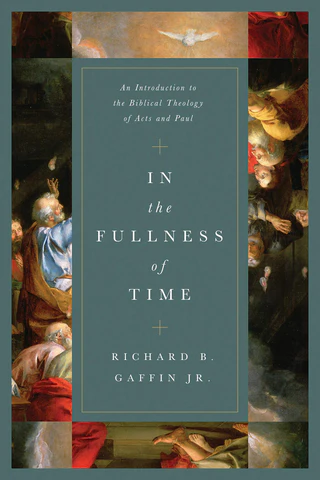
Richard B. Gaffin Jr.
Reviewed by: John Muether and John Mahaffy
In the Fullness of Time: An Introduction to the Biblical Theology of Acts and Paul, by Richard B. Gaffin Jr. Crossway, 2022. Hardcover, 448 pages, $41.89 (Amazon). Two reviews by OP ruling elder John Muether and OP pastor John Mahaffy.
I was “Gaffinized” in 1979, when I took the four-semester-hour class New Testament Introduction: Acts and the Pauline Epistles under Dr. Richard Gaffin Jr. at Westminster Theological Seminary in Philadelphia. As Sinclair Ferguson explains in the foreword to In the Fullness of Time, “To be ‘Gaffinized’ is to come under the influence of Dr. Gaffin’s gracious teaching in such a way that it—and he—left a lifelong impression on your understanding of the gospel and its deep structures” (17). Although it was an elective course for me, it was as formative as anything else I studied at seminary.
Reading In the Fullness of Time was a delightful return to that classroom. Still-familiar Gaffinisms leapt off almost every page for me. I can vividly remember many expressions from this book from classroom lectures. For example, Gaffin’s playful re-titling of the books of Acts— “Acts of the Exalted Christ by the Holy Spirit in the Church as Founded by Him through the Apostles”—was a mouthful, he acknowledged, but every word did justice to all that is involved in fully understanding the book (59).
Understanding the Miracle of Pentecost
Like the course that Gaffin taught for thirty-three years to students numbering in the thousands, this book is roughly one-third on Acts and two-thirds on Paul. Much of the theology of Acts depends on understanding the miracle of Pentecost. Gaffin argues that Pentecost belongs to the accomplishment of redemption (historia salutis) not the order of salvation (ordo salutis): it is rightly understood as part of the “death-resurrection-ascension-Pentecost” complex of events (169–170), and therefore, Pentecost is “unrepeatable and irrevocable” (124). Moreover, this complex reveals the coming of the kingdom not in two but in three stages, the resurrection and Pentecost having launched the church age as stage-two of the kingdom (79). What emerges from this construction is a better cessationism, or perhaps, more positively stated, a more coherent understanding of how the Spirit is at work in the church today. Being filled with the Spirit is a controlling, continuing, and comprehensive reality for the whole church (146–151). It is not reserved for charismatic moments, but rather it bears on the everyday experience of all Christians.
Pentecost then shapes the “two-aeon” construction of Paul’s eschatology. In exegeting key Pauline passages, Gaffin notes the tendency of modern translations to miss the force of Paul’s argument. For example, in 2 Corinthians 5:17, Paul is not simply describing Christians as “new creatures” but boldly proclaiming that the “new creation has come” (260).
New Created Order
Two features of this new created order draw Gaffin’s particular attention. First, the Christian life is the resurrected life, and Gaffin presses the reader not to reduce this to a future hope but to grasp it as a present reality: the “resurrection of Christ is the same resurrection-harvest as the resurrection of believers” (307). Gaffin put this in a most provocative way that still rings in my memory from hearing it decades ago. “If you are a believer in Christ,” Gaffin insists, “united to him by faith, then at the core of your being (the heart), in the deepest recesses of who you are, you will never be more resurrected than you already are” (317; see also 367).
Secondly, the power of the resurrection in the life of the Christian is realized—not despite nor in addition to, but precisely—in our fellowship with Christ in his suffering. The church triumphs through its suffering just as its Savior did. This is a more theologically grounded definition of suffering, applying beyond the “persecuted church” to the whole church, even in the West, and once again, applies in the mundane and the ordinary (417).
In the Fullness of Time is skillfully edited to retain the stylistic feel of an introductory seminary class, which enhances its accessibility (footnotes, for example, are kept to a minimum). This book will kindle warm memories in Westminster alumni of the cinderblock walls of Van Til Hall. But it will also introduce future generations of readers to the depth of Gaffin’s exegetical insights and perhaps prompt many of them to read his further development of these themes in his Perspectives on Pentecost and Resurrection and Redemption.
* * * * *
Click here for a second review of this book by John Mahaffy.
April 13, 2025
Suffering: God’s Purpose in Our Pain
April 06, 2025
Sunday Matters: 52 Devotionals to Prepare Your Heart for Church
March 30, 2025
On the Trail with a Missionary
March 23, 2025
Midnight Mercies: Walking with God Through Depression in Motherhood
March 16, 2025
March 09, 2025
Zwingli the Pastor: A Life in Conflict
March 02, 2025
© 2025 The Orthodox Presbyterian Church